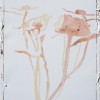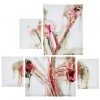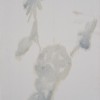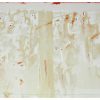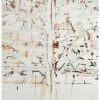2012-2015
- Untitled, From “Shadows of Eden” series, 2012, Oil on Canvas, 180×130 cm
- Untitled, From “Shadows of Eden” series, 2012, Oil on Canvas, 180×130 cm
- Untitled, From “Shadows of Eden” series, 2012, Oil on Canvas, 120×100 cm
- Untitled, From “Shadows of Eden” series, 2012, Oil on Canvas, Diptych, 150×200 cm
- Untitled, From “Shadows of Eden” series, 2013, Oil on Canvas, 40×30 cm
- Untitled, From “Shadows of Eden” series, 2012, Oil on Canvas Board, (5 Panel), 54×57 cm
- Untitled, From “Shadows of Eden” series, 2013, Oil on Canvas, Diptych, 150×200 cm
- Untitled, From “Shadows of Eden” series, 2013, Oil on Canvas, 30×30 cm
- Untitled, From “Shadows of Eden” series, 2013, Oil on Canvas, Diptych, 120×200 cm
- Untitled, From “Shadows of Eden” series, 2015, Oil on Canvas, 130×180 cm
- Untitled, From “Shadows of Eden” series, 2015, Oil on Canvas, 180×130 cm
Modern Art and Garden of Eden
The experience of art is an experience after the world has come to an end…. When reduced to pure and naked existence, like the existence of the shades Ulysses visits in Hades, life dissolves into a shadow.
— Emmanuel Levinas
The Garden of Eden, a metaphor for light and blossoming, the place for happiness and proximity, is the original exemplar of the youth of a village described in the beginning of the novel One Hundred Years of Solitude by Marquez: “… built on the bank of a river of clear water that ran along a bed of polished stones….” Besides youth and light, it is the concept of magic that bridges the two places to Marquez’s novel. It is the shibboleth that unlocks the gate to the realm of art and all discussions about it. But before magic, it is the Garden of Eden itself that somehow characterizes art. The pre-modern artist whose art used to serve religion and rituals, considered his mission to be imitating the creative act of the Creator; or as Walter Benjamin puts it, the Adamite used to replicate the creative act of God in naming the creatures. The immediacy or magic of Adamite language was the echo of the silent talks of nature reaching his attentive mind. After the fall from paradise, nature, too, lost its call and man’s language took an instrumental and communicative character. Modern art that misses any link to Eden, thus, is due to obliterate this surplus aspect of language, refusing to act as a medium to convey information and conceptual knowledge. Within so many artistic theories and reflections on art, this understanding has had repercussions. For instance, Levinas states “Art … contrasts with knowledge. It is … a descent of the night, an invasion of shadow. To put it in theological terms: [modern] art does not belong to the order of revelation. Nor does it belong to that of creation”. Modern art is the art of dark light and shadows. On the other hand, the modern artist nevermore fills his canvas with image. Rather, he eradicates it from all kinds of visuals: Malevich’s black and white squares and Jasper Johns’ wiping out De Kooning’s drawing are standard translations of such approach.
Shadows of Eden
The paintings from the Shadow of Eden series could be, however roughly, compared with Andy Warhol’s works such as his pictures of Monroe, Mick Jagger or Mao which are fading repetitions of a single picture. They could also be explained in respect of Levinas’s statement saying “to paint a world that is emptied of objects”. Or described as “poor painting” (as in Grotowski’s poor theater) because of the simplicity and daunting dominance of negative space in each one of them. In the paintings, parts of flowers or plants (mostly leaves) are reiterated in one or two faint colors and faded away gradually. And the process of fading away has afflicted the visual form as well. The coming together of these particular paintings creates a rhythm, not in its usual sense as in music that witnesses the inner law of the artistic order of the works, but as a means by which parts of a single painting, as well as the entire works of the series impose themselves on viewers, and hence, disengage themselves from reality. The incompleteness and destituteness of the paintings invoke neither deficiency nor scarcity but completeness and unanimity. Rhythm, here, embodies a situation in which the paintings open up to us without us having asked for it. Or rather, their entry into us is one with our entry into them. It is in this rhythm that I/eye are replaced by a place in which artworks and viewers contribute to a community whereby
another mode of being is experienced.1 This mode of being is not being in both consciousness and unconsciousness but of waking from a dream, of a state of being shrouded in aura of virgin novelty and unreality. This formula is as the very explanation that was presented by Charles Baudelaire in his “The Painter of Modern Life” about Constantin Guys. It said of a state of seeing the world after a prolonged malaise, of a state which is one of the first, forerunner formulas of modernism.
Shahriar Vaghfipour- Winter 2013
- The main technique of modernism is being faithful of an artwork to its own medium. On the one hand, the word of milieu comprises of Latin word of medius, that is the original form of medium, and lieu, Latin word for place. On the other, medius means mode too.




